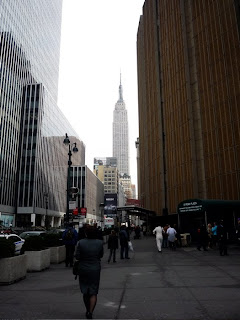Walking Off the Wall Street Bears, Part II: The Crisis at Lehman Brothers, and You
 I've been reading the dire financial news breaking today, the precipitous collapse of Lehman Brothers Holdings Inc., and wondering how a potential bankruptcy or breakup of the firm might affect life in the greater New York area. While various news outlets such as The New York Times, Bloomberg News, thestreet.com, and The Wall Street Journal have done excellent reporting on the financial aspects of the collapse of the talks underway downtown, the New York Daily News best addresses the needs of the average citizen with headlines such as "Layoffs in financial market hurt city."
I've been reading the dire financial news breaking today, the precipitous collapse of Lehman Brothers Holdings Inc., and wondering how a potential bankruptcy or breakup of the firm might affect life in the greater New York area. While various news outlets such as The New York Times, Bloomberg News, thestreet.com, and The Wall Street Journal have done excellent reporting on the financial aspects of the collapse of the talks underway downtown, the New York Daily News best addresses the needs of the average citizen with headlines such as "Layoffs in financial market hurt city."As of this writing, Lehman Brothers, a financial house that dates back to 1850, may succumb to recent stock pressures and be headed for liquidation before markets open on Monday. Barclays PLC and Bank of America (in hard breaking news as I write, in talks to buy Merrill Lynch), two potential suitors, have left the building (as pictured here, the Federal Reserve Bank of New York on Liberty Street). The U.S. government, after rescuing Fannie Mae and Freddie Mac, two big mortgage holders, isn't interested in another rescue. The worry is that the collapse of Lehman foreshadows the demise of other institutions such as AIG (American International Group) and WaMu (Washington Mutual).
New York City depends to a great extent on the Wall Street firms for its overall health. The city enjoys the taxes paid by these firms for the municipal budget. The lesser the revenue, the pressure mounts to cut back on services. Furthermore, Wall Street jobs are high-paying ones for the most part, and the loss of jobs with the selling off of the Lehman assets would result, as it did with Bear Stearns, in ripple effects throughout the local economy. As the Daily News reports today, "Rough times on Wall Street have put more than 76,000 workers in the financial services industry out of a job, experts say. And with Lehman Brothers on the brink of collapse, another 12,000 New York City employees could join their ranks."
These job losses, of course, affect the real estate market, the restaurant business and countless enterprises in the service sector.
A roundup of useful articles, thusly:
• "Layoffs in financial market hurt city," by Heidi Evans, Daily News Staff Writer.
• "New York’s Next Fiscal Crisis: Mayor Bloomberg needs to prepare the city for the crash of the Wall Street gravy train," by Nicole Gelinas for City Journal. Summer 2008.
• "Losers abound in Lehman's fall" by Aaron Elstein for Crains New York.
• For an earlier story from March 2008, see "With Economy Tied to Wall St., New York Braces for Job Cuts" by Louise Story from The New York Times.
• And from an even earlier fictional story, The House of Mirth by Edith Wharton (1905):
"It had been a bad autumn in Wall Street, where prices fell in accordance with that peculiar law which proves railway stocks and bales of cotton to be more sensitive to the allotment of executive power than many estimable citizens trained to all the advantages of self-government. Even fortunes supposed to be independent of the market either betrayed a secret dependence on it, or suffered from a sympathetic affection: fashion sulked in its country houses, or came to town incognito, general entertainments were discountenanced, and informality and short dinners became the fashion." See my previous post, "New York in The House of Mirth: Social Class, Money, and Speculations on Wall Street."
• For cultural background on the crisis in subprime mortgages, read the original sequence of posts, Walking Off the Wall Street Bears.
A most fascinating week on Wall Street awaits. I'm not kidding. Alan Kohler, in a commentary for Business Spectator filed late this afternoon, writes, "The next 24 hours will be one of the most decisive and significant in our lifetimes." Golly. See "Lehman end-game."
Image: Federal Reserve Bank of New York, 33 Liberty Street. Neo-Renaissance. 1919-1924, with extension in 1935. York & Sawyer, architects. The gold of many nations is stored in its subterranean vaults. Image by Walking Off the Big Apple.
See New York 1900: Edith Wharton and The House of Mirth, A Walk and a Map for the several related posts.





A great series of posts and rightly concerned with recent and continuing difficulties in the financial sector. At times like these many say spiteful things about those whose jobs in the sector are sacrificed; I hope anyone whose life has been turned upside down by this collapse and reading this understands some of us are more generous spirited.
ReplyDeleteBut oh! To be in New York! Wonderful city, even at times like these! Keep the faith!